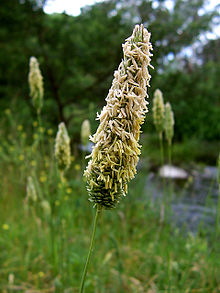
Back Naleueng ACE Gras Afrikaans حشيش (عشب) Arabic Žuolie BAT-SMG Трева Bulgarian घास Bihari Kumpai BJN རྩ། Tibetan Tráva Czech Gras German
| Grasses Temporal range: [1]
| |
|---|---|

| |
| Flowering head of meadow foxtail Alopecurus pratensis | |
| Scientific classification | |
| Kingdom: | Plantae |
| Clade: | Tracheophytes |
| Clade: | Angiosperms |
| Clade: | Monocots |
| Clade: | Commelinids |
| Order: | Poales |
| Clade: | Graminid clade |
| Family: | Poaceae John Hendley Barnhart[2] |
| Type genus | |
| Poa | |
Grass is a type of plant with narrow leaves growing from the base. Their appearance as a common plant was in the mid-Cretaceous period. There are 12,000 species now.[3]
A common kind of grass is used to cover the ground in places such as lawns and parks. Grass is usually the color green. That is because they are wind-pollinated rather than insect-pollinated, so they do not have to attract insects. Green is the best colour for photosynthesis.
Grasslands such as savannah and prairie are where grasses are dominant. They cover 40.5% of the land area of the Earth, but not Greenland and Antarctica.[4]
Grasses are monocotyledon herbaceous plants. They include the "grass" of the family Poaceae, which are called grass by ordinary people. This family is also called the Gramineae and includes some of the sedges (Cyperaceae) and the rushes (Juncaceae).[5] These three families are not very closely related, though all of them belong to clades in the order Poales. They are similar adaptations to a similar life-style.
With about 780 genera and about 12,000 species,[3] the Poaceae is the fifth-largest plant family. Only the Asteraceae, Orchidaceae, Fabaceae and Rubiaceae have more species.[6]
The true grasses include cereals, bamboo and the grasses of lawns (turf) and grassland. Uses for graminoids include food (as grain, shoots or rhizomes), drink (beer, whisky), pasture for livestock, thatch, paper, fuel, clothing, insulation, construction, basket weaving and many others.
Many grasses are short, but some grasses can grow tall, such as bamboo. Plants from the grass family can grow in many places and make grasslands, including areas which are very dry or cold. There are several other plants that look similar to grass and are referred to as such but are not members of the grass family. These plants include rushes, reeds, papyrus and water chestnut. Seagrass is a monocot in the order Alismatales.
Grasses are an important food for many animals, such as deer, buffalo, cattle, mice, grasshoppers, caterpillars and many other grazers. Unlike other plants, grasses grow from the bottom, so when animals eat grass, they usually do not destroy the part that grows.[7] This is part of the reason why the plants are so successful.
Without grass, more soil might wash away into rivers (erosion).
- ↑ Yan Wu; Hai-Lu You; Xiao-Qiang Li (2018). "Dinosaur-associated Poaceae epidermis and phytoliths from the Early Cretaceous of China". National Science Review. 5 (5): 721–727. doi:10.1093/nsr/nwx145. ISSN 2053-714X.
- ↑ Angiosperm Phylogeny Group (2009). "An update of the Angiosperm Phylogeny class classification for the orders and families of flowering plants: APG III". Botanical Journal of the Linnean Society. 161 (2): 105–121. doi:10.1111/j.1095-8339.2009.00996.x.
- ↑ 3.0 3.1 Christenhusz, M.J.M.; Byng, J.W. (2016). "The number of known plants species in the world and its annual increase". Phytotaxa. 261 (3): 201–217. doi:10.11646/phytotaxa.261.3.1. Archived from the original on 2016-07-29.
- ↑ Reynolds, S.G. "Grassland of the world". www.fao.org. Archived from the original on 2016-09-20. Retrieved 2016-10-04.
- ↑ Chapman G.P. & Peat W.E. 1992. An introduction to the grasses. Oxford: CAB Internat.
- ↑ "Angiosperm Phylogeny Website". Archived from the original on 23 March 2016. Retrieved 20 March 2016.
- ↑ Cheplick G.P. 1998. Population biology of grasses. Cambridge University Press.